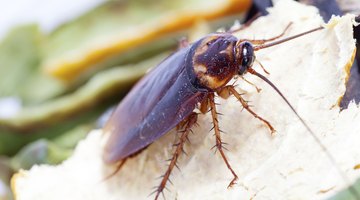How to Kill Cockroaches With Diatomaceous Earth
Cockroaches are more than an indoor nuisance and potential health hazard; these annoying pests can also damage indoor and outdoor plants.

If you're looking for a safe, organic pest control method to kill these creepy crawlies, try using diatomaceous earth, a natural product that can be found in home improvement stores, health food stores and online. You can also make your own natural repellant by mixing 3 ounces or rosemary or garlic essential oil and 1 teaspoon of dish-washing soap into 1 gallon of water and spraying it in the affected areas.
Identifying Cockroaches and Plant Damage
Cockroaches feed on all types of vegetation, ranging from indoor food droppings to the leaves and flowers of both indoor and outdoor plants. Roaches may chew on indoor houseplants such as orchids or outdoor ornamentals, fruit plants and vegetable plants. Signs of roach damage include nibbled leaves and flowers. Roaches also feed on plant roots and root tips, which can ultimately destroy the affected plants.
Identifying cockroaches is easy at the egg stage. Unlike other insects and pests, roaches create small caselike enclosures to protect the eggs. Once they hatch, the small nymphs shed their outer skin as they grow. After shedding their skin, the young roaches have soft, white bodies until they mature and develop their characteristic dark, hard shell.
Small cockroaches such as the German cockroach, which has a tan-colored, 1/2-inch body, typically infest indoor spaces. Outside, you're more likely to encounter large cockroaches, such as the American cockroach, with its reddish-brown, 2-inch body. American cockroaches have a yellow marking around the head.
How Diatomaceous Earth Works
Diatomaceous earth is a fine dust made of diatoms, a form of algae with silicon dioxide shells. In addition to being a safe, organic method for controlling pests, food-grade diatomaceous earth can also be found in skin-care products, pet food and on the shelves of many health food stores as a supplement that's safe for human consumption.
The fine dust works by absorbing fats and oils from the outer layer of the hard shell that covers roaches and other pests. The tiny particles have abrasive edges that further break the shell down. Ultimately, the pests are unable to retain moisture, become dehydrated and die. For this reason, you may notice that the roaches are more visible as they search for water. The pests should die within two weeks of treatment.
Application Methods
Sprinkle a light coating of diatomaceous earth on the surface of the soil in affected areas. Use a bulb puffer to blow the dust onto the surface of your plants and into crevices where roaches may be hiding, including cracks and open spaces indoors. You can also apply the dust directly onto nests, in any cracks or crevices in outdoor walls and buildings and around the exterior of your home. For maximum effect, use diatomaceous earth during dry weather. If you're using it outdoors and it rains, reapply the dust to all treated areas.
Precautions and Warnings
Only use food-grade diatomaceous earth, a pure product that’s nontoxic to humans and pets. Don’t confuse it with the diatomaceous earth used to filter pools. The material used in pools comes from the same source but is chemically treated and melted during processing. Pool-grade diatomaceous earth presents a significant risk of respiratory damage.
Although you can use insect-grade diatomaceous earth, which typically includes insecticides such as pyrethrin, in most cracks and crevices and on ornamental plants, when you're treating edible plants or areas where humans and pets may come into contact with the dust, choose food-grade diatomaceous earth, which doesn't include the added chemicals. Although it's nontoxic, the fine dust can be irritating if it gets in your eyes or if you accidentally breathe it. Wear a dust mask, gloves and goggles to avoid irritating your skin, eyes or lungs as you apply the diatomaceous earth.
The Drip Cap
- Cockroaches are more than an indoor nuisance and potential health hazard; these annoying pests can also damage indoor and outdoor plants.
- Unlike other insects and pests, roaches create small caselike enclosures to protect the eggs.
- Outside, you're more likely to encounter large cockroaches, such as the American cockroach, with its reddish-brown, 2-inch body.
- The tiny particles have abrasive edges that further break the shell down.
- Use a bulb puffer to blow the dust onto the surface of your plants and into crevices where roaches may be hiding, including cracks and open spaces indoors.
- For maximum effect, use diatomaceous earth during dry weather.
- Although you can use insect-grade diatomaceous earth, which typically includes insecticides such as pyrethrin, in most cracks and crevices and on ornamental plants, when you're treating edible plants or areas where humans and pets may come into contact with the dust, choose food-grade diatomaceous earth, which doesn't include the added chemicals.
References
Writer Bio
Caryn Anderson combines extensive behind-the-scenes writing experience with her passion for all things food, fashion, garden and travel. Bitten by the travel bug at the age of 15 after a trip to Europe, Anderson fostered her love of style and fashion while living in New York City and earning her degree at New York University.
Photo Credits
- Panya_/iStock/Getty Images
- Panya_/iStock/Getty Images
More Articles



